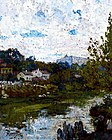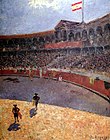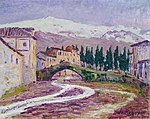Darío de Regoyos
Darío de Regoyos y Valdés (November 1, 1857 – October 29, 1913) was a
His works include El paseo de Alderdi Eder (1894), Penaas de Duranguesado, La España Negra: Víctimas de la fiesta (1894), Mercado de Villarnaca de Oria (1909), Gallinero (1912) and Polluelos (1912).[1] Though his work was not very popular during his lifetime, after his death, a tribute exhibition was devoted to him in the Biblioteca Nacional de España in Madrid. Collections of his art are held by the Bilbao Fine Arts Museum, the Museu Nacional d'Art de Catalunya in Barcelona, Abelló Museum in Vallès Oriental, and the Carmen Thyssen Museum in Málaga. He died in 1913 and was buried in the Sant Gervasi Cemetery, Barcelona.
Early years
Regoyos was born in
Career

Between 1881 and 1893, he travelled between Belgium, the Netherlands, and Spain. In 1882, he travelled to Morocco and Spain with Théo van Rysselberghe and Frantz Charlet. In the 1880s, he made several trips to Paris,[4] accompanied by his friend, painter Adolfo Guiard.[5] During these experiences he gained a significant influence from Impressionist and Neo-Impressionist painters.[6] He encouraged exhibitions, concerts and other cultural activities in order to develop modern art in Belgium. As such, he was a member of the art group L'Essor and a founding member of Les XX with the Belgian avant-garde scene.[4] He mixed with painters such as Théo van Rysselberghe and Frantz Charlet, Pissarro, Seurat, and Signac.[2] Regarding his 1912 oil on canvas, Le Poulailler ("The Henhouse"), José Ortega y Gasset said that Regoyos "seemed to kneel to paint a cabbage".[7] He also painted several smoking locomotive paintings.[5] In 1883, he accompanied several painters on a tour of Spain, settling in the country the following year. He married in Spain in 1895, but continued to make multiple trips out of the country.

Regoyos died of cancer in Barcelona in 1913. Though his work was not very popular during his lifetime, after his death, a tribute exhibition was devoted to him in the
Style
In his early stage, Regoyos' painting evolved from
Gallery
-
The Henhouse (1912)
-
La Concha, nocturno ('La Concha at night") (c. 1905)
-
Rivera del Manzaneres (c. 1909)
-
Mercado de Villafranca de Oria (1909)
-
Tendido de sombra ("Pulling shadow") (1882)
-
Sierra Nevada
-
Vendredi Saint en Castille ("Good Friday in Castile")
See also
References
- ^ ISBN 978-84-9948-348-1. Retrieved 10 October 2012.
- ^ ISBN 978-84-7491-707-9. Retrieved 10 October 2012.
- ^ a b c San Nicolás, Juan. "Darío de Regoyos y Valdés". Museo Thyssen-Bornemisza. Retrieved 6 October 2012.
- ^ ISBN 978-0-913689-35-6. Retrieved 6 October 2012.
- ^ ISBN 978-0-7546-6029-3. Retrieved 6 October 2012.
- ISBN 978-0-8109-4131-1. Retrieved 10 October 2012.
- ^ "Darío de Regoyos (1857-1913) (véase Cantarino 334)" (in Spanish). Western Michigan University. Retrieved 6 October 2012.
- ^ "Dario de Regoyos". Philateca. Retrieved 6 October 2012.








